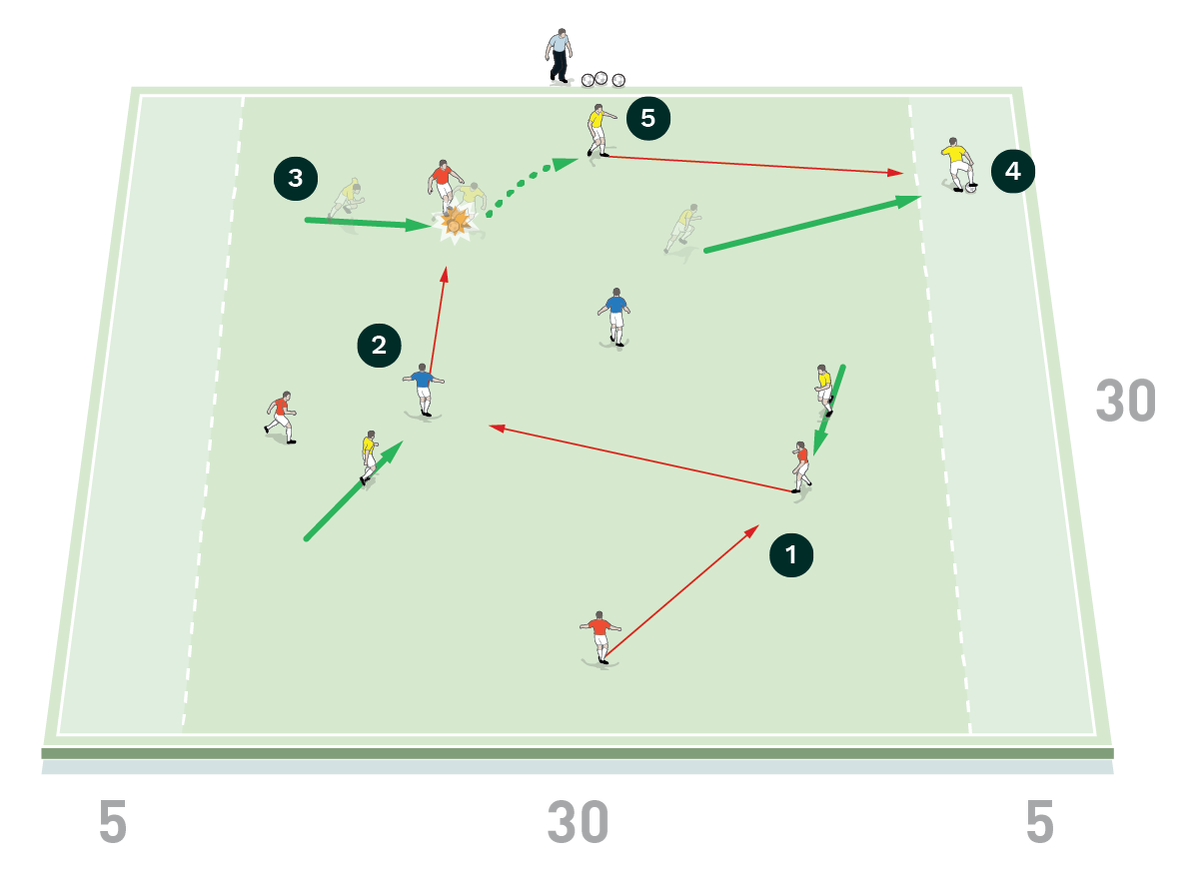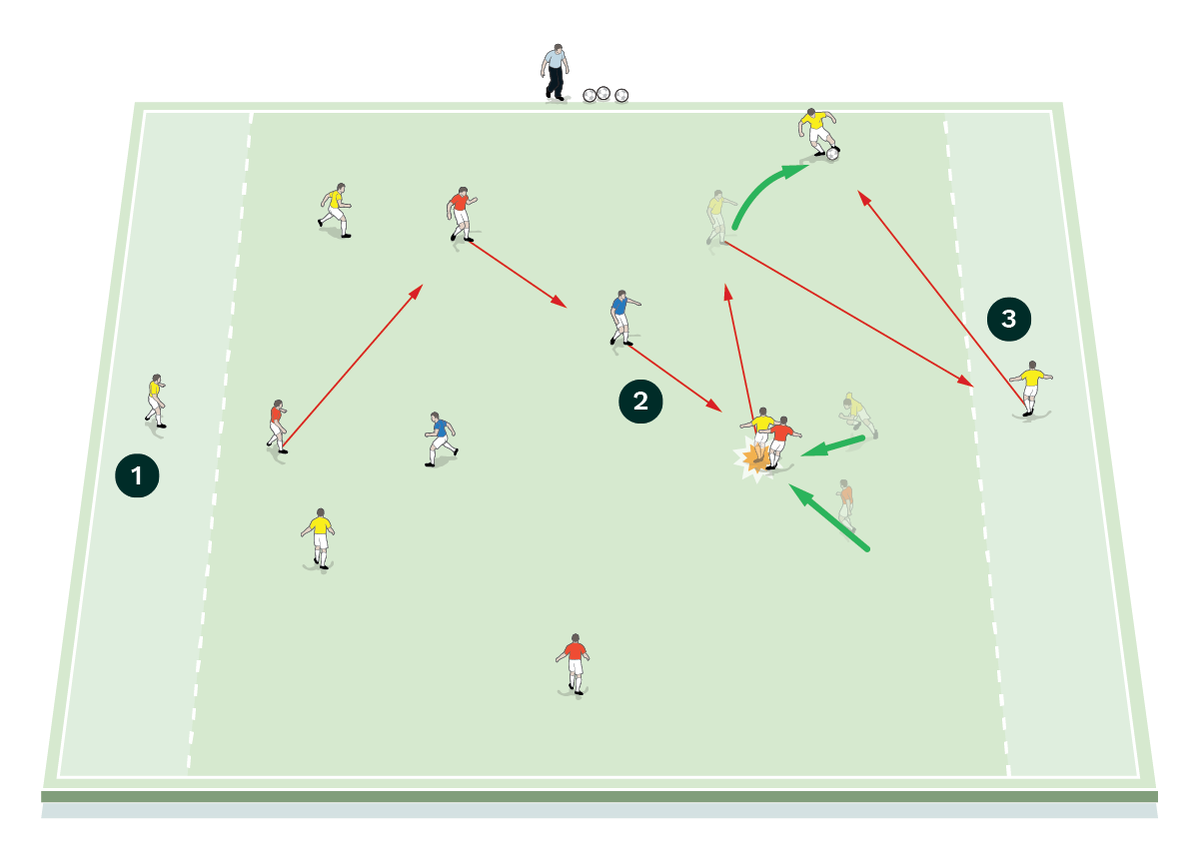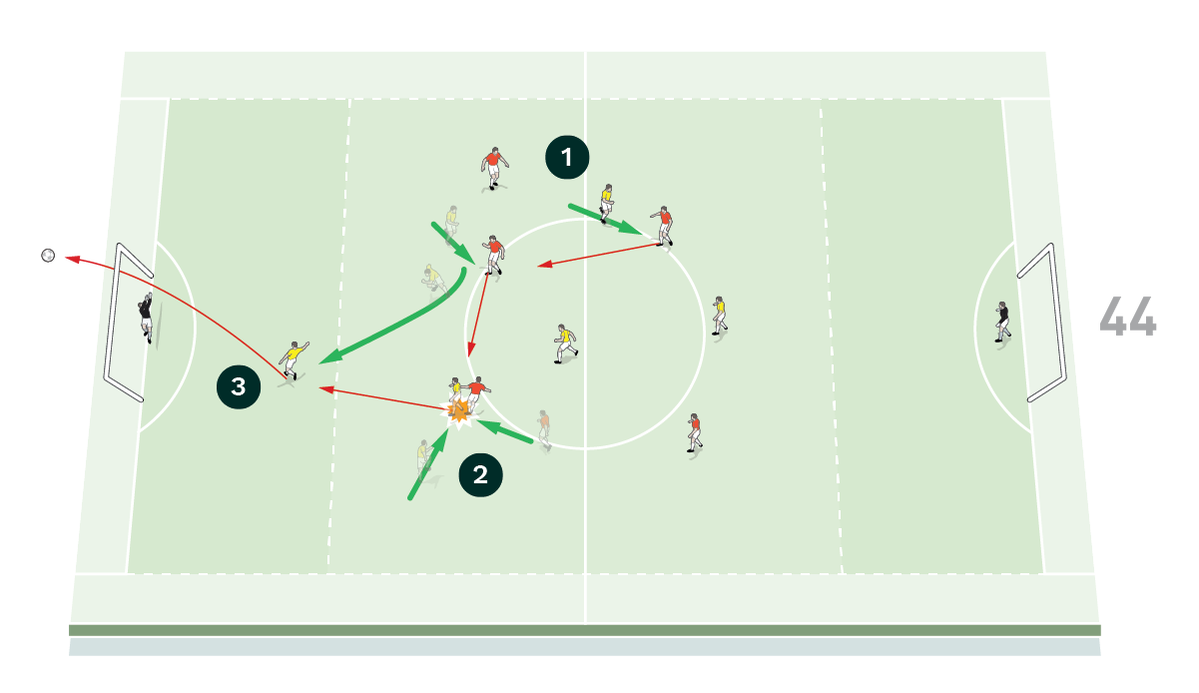Pivot play and forward running
This session is about encouraging pivot play, with an emphasis on midfield movement.

| Area | Up to two thirds of pitch |
| Equipment | Balls, bibs, cones, 2 full size goals |
| No. of Players | Up to 12 players + 2 goalkeepers |
| Session Time |
Hit the blue: 20mins |
This session is about encouraging pivot play, with an emphasis on midfield movement. It is a possession-based practice that encompasses both in-possession and out-of-possession principles of play. The game realism within this practice engages and enthuses the players, as does the focus on individual outcomes based on position-specific player roles and responsibilities.
This practice was designed to ensure that under-maturated players (the blue pivot players) receive the ball at every feasible opportunity. This practice allows for chaos within a structure, where the players have a clear idea of what’s in it for them – this is a central part of my coaching within the development arena.
The session affords coaches the opportunity to adapt the emphasis determined by the area of focus. We could therefore have either an attacking or defending emphasis and still use the same session. Although variety is important, I think changing sessions and practices too often can result in losing time for purposeful learning because of the time spent explaining rules and instructions.
It’s important to reflect on who the session is for and the different ways in which players learn. Repetition helps players to cement learning and master techniques.
“It is a possession based practice that encompasses both in-possession and out-of-possession principles of play”
HIT THE BLUE
We set up a playing area of 40x30 yards with five-yard end zones at each end. We’re using 10 outfield players split into two teams of four (the reds and the yellows) and two neutral blue pivot players.
A red player starts on the ball. The reds aim to pass in the central area, combining with the two blue neutral pivot players to maintain possession under pressure from the defending team.
The yellow defending team swarms around the possession team and tries to win the ball. If they suceed, their job is to find a forward runner to pass to in the end zone. The runner must receive the pass in the end zone under control to score a point, as shown [1a].
[1a]

- A red player starts with the ball. The reds join with the two neutral blues to keep possession in central area
- The two blues are neutral pivot players who play for the red possession team
- The yellow defending team swarm to gain possession
- If the yellows win the ball back, their job is to find a forward runner to pass to in the end zone to score a point
- Once a point has been scored, the game goes dead and restarts with a new ball from the coach. The coach can decide who to play to
Once a point has been scored, the game is dead and restarts with a ball from the coach. The coach decides who to play to.
As a progression, two additional players – ideally goalkeepers to improve their footwork – can be added to the yellow defending team and they are positioned in the end zones as target players. These target players can move along the line and are used to support play. The red team and the two blues combine as before to maintain possession under pressure from the yellow defending team, who swarm to try and win the ball. If the defending team wins the ball, they have to play it to a target player. Once the target player receives it, they play back to the yellows and the yellows now have to recycle the ball to the target player on the other side.
If the reds and blues win it back, they must pass the ball around the central area again and look to maintain possession, as shown [1b].
[1b]

- As a progression two end zone target players are added to the yellow defending team. These players can move along the line and be used to support play
- The red team maintains possession in the middle area by using the support of the blue pivot players
- The yellows swarm around the ball and if they win it they have to play the ball to a target player in the end zone. Once the target receives it, they play it back to a yellow. The yellows must now recycle the ball to the other side
“As a progression, additional players – preferably goalkeepers to improve their footwork – can be added to the yellow defending team and they are positioned in the end zones as target players”
FORWARD RUNNING
While Practice 1 is all about cementing the learning of purposeful possession with pivot play, this practice can adapt those principles to put the emphasis on forward running.
We set up a playing area between the two penalty boxes, coning it off to the width of the penalty area. A full size goal and a goalkeeper are positioned at each end and a central midfield box is created by the addition of an offside line in each half.
We’re using 10 outfield players split into two teams of six including goalkeepers. All of the outfield players start in the main central midfield area and play begins with the red team in possession of the ball. The yellow team presses to win the ball back. Teams get one point every time they score a goal and they should be encouraged to demonstrate what they have learnt thus far by playing through balls to one forward runner who is allowed to break out of the central area alone (untracked) to receive the pass in the end zone and finish with a shot on goal, as shown [2].
[2]

- All of the outfield players start in the main central midfield area and play begins with the red team in possession
- The yellow team presses to win the ball back
- Teams get one point when they score and they should be encouraged to play through balls to an untracked forward runner who receives the pass and finishes with a shot on goal
The game can be progressed further by allowing more than one player to make a forward run, or allowing defenders to recover and track attacking players into the scoring area.
COACHING POINTS
What are the key things to look out for?
As this practice has an attacking emphasis, I would insist that the pressing team swarms around the possession team with intent and urgency to put the attacking players under pressure. This allows for thinking ahead, early decision making and variation in movement.
The pressure from the defenders also encourages quick combination play by the attacking team, if they are to maintain possession of the ball.
What are the typical mistakes players might make and how do I avoid them?
In the first practice, the pivot players may have the tendency to lack pitch discipline and navigate towards the ball. Visual aids can help the players understand pitch geography. A balance line may also assist in providing the players a reference when considering rotations, interchange and balance.
Another typical mistake that players can make is that the pivot players turn into pressure due to a lack of scanning. Often there is a lack of trust in passing into the blue pivot players, therefore this will need to be observed and encouraged by the coaches.
Editor's Picks
Attacking transitions
Deep runs in the final third
Using the goalkeeper in build-up play
Intensive boxes drill with goals
Penetrating the final third
Creating and finishing
My philosophy
Pressing initiation
Compact team movement
Coaches' Testimonials

Alan Pardew

Arsène Wenger

Brendan Rodgers

Carlos Carvalhal

José Mourinho

Jürgen Klopp

Pep Guardiola

Roy Hodgson

Sir Alex Ferguson

Steven Gerrard
Coaches' Testimonials

Gerald Kearney, Downtown Las Vegas Soccer Club

Paul Butler, Florida, USA

Rick Shields, Springboro, USA

Tony Green, Pierrefonds Titans, Quebec, Canada
Join the world's leading coaches and managers and discover for yourself one of the best kept secrets in coaching. No other training tool on the planet is written or read by the calibre of names you’ll find in Elite Soccer.
In a recent survey 92% of subscribers said Elite Soccer makes them more confident, 89% said it makes them a more effective coach and 91% said it makes them more inspired.
Get Monthly Inspiration
All the latest techniques and approaches
Since 2010 Elite Soccer has given subscribers exclusive insight into the training ground practices of the world’s best coaches. Published in partnership with the League Managers Association we have unparalleled access to the leading lights in the English leagues, as well as a host of international managers.
Elite Soccer exclusively features sessions written by the coaches themselves. There are no observed sessions and no sessions “in the style of”, just first-hand advice delivered direct to you from the coach.









